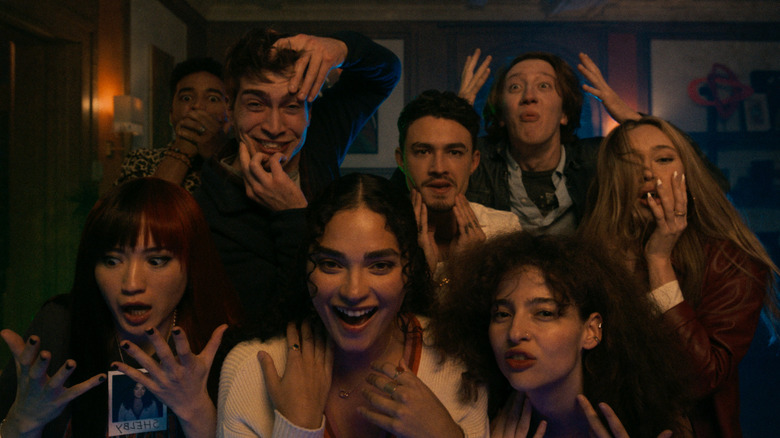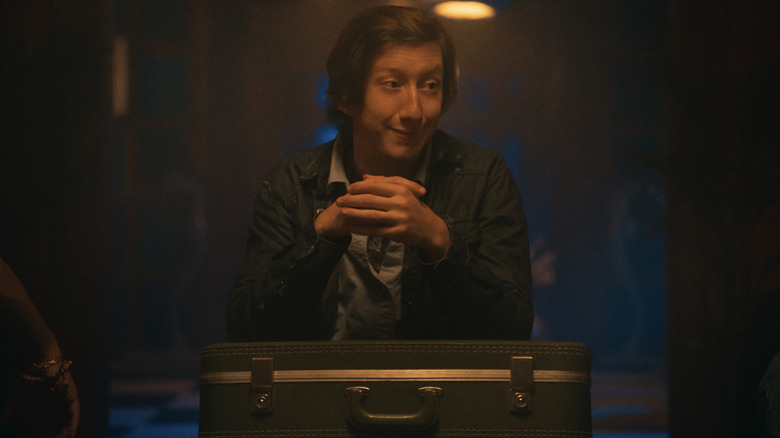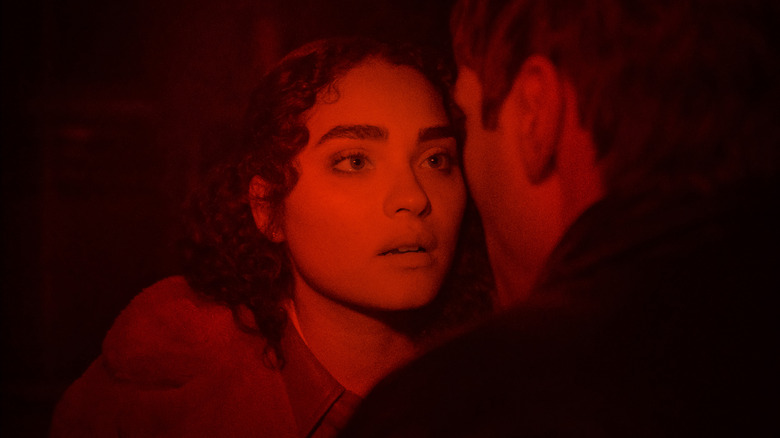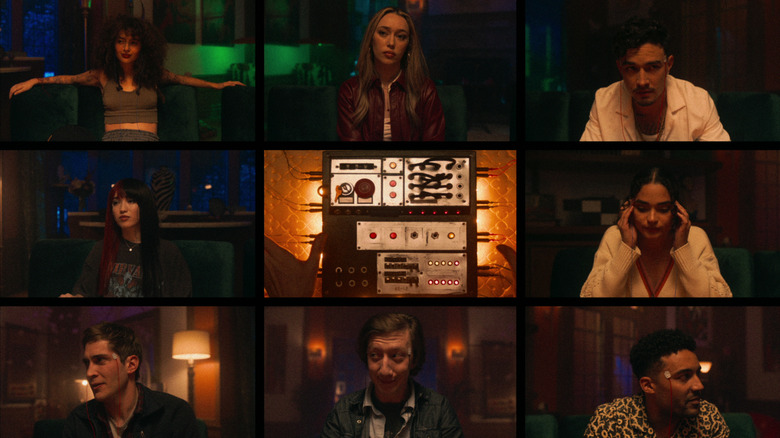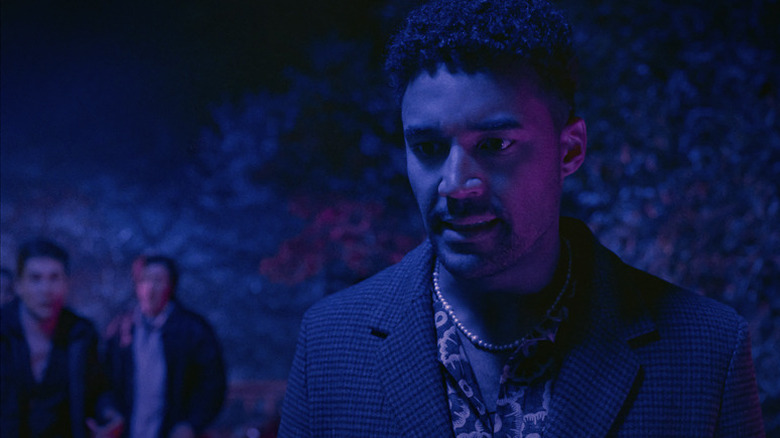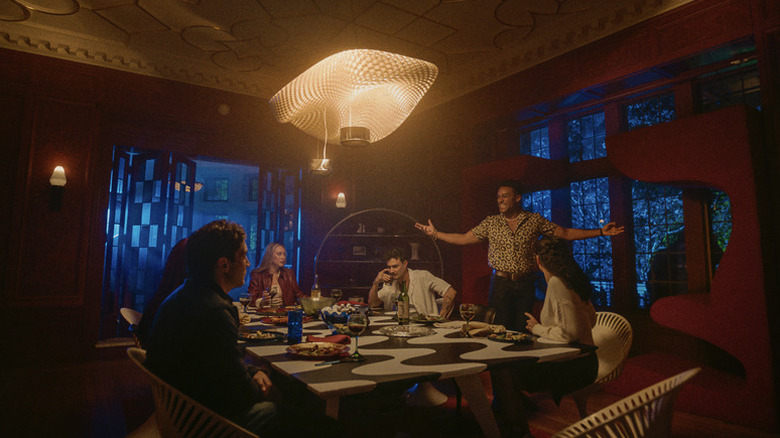How It's What's Inside's Director Shot One Of 2024's Most Exciting Films In Just 18 Days [Exclusive Interview]
One of the highest-profile acquisitions from this year's Sundance Film Festival is finally available for all to see (well, as long as you have a Netflix subscription). The movie is "It's What's Inside," a twisted new sci-fi thriller about a group of college friends who reunite the night before a wedding, and one of their strange pals shows up invited with a mysterious suitcase. The group ultimately decides to play a game — one that has consequences they never could have predicted, which allows simmering tensions, resentments, and attractions between members of the group to be explored in ways that are sometimes sexy, cathartic, horrifying, or all of those things simultaneously.
The movie marks the feature directorial debut of Greg Jardin, an exciting new voice in filmmaking who has directed a few shorts and music videos and is hopefully going to get a well-deserved career boost when audiences realize how unusual and creative this project truly is. If you find yourself worn out by the summer movie season or depressed that Hollywood lacks originality, let this movie be a temporary balm for those feelings.
I recently had the chance to speak with Jardin about his inspirations for the project, its breakneck 18-day shoot, the enormous amount of trust he put in his actors, what he learned while editing the movie, and more.
Note: This interview contains spoilers for "It's What's Inside," and has been lightly edited for clarity and brevity.
A game of Mafia helped inspire It's What's Inside
"It's What's Inside" is your feature directorial debut. Before we talk about that, though, I want to ask about "Cowboy Bebop: Lost Session." I was looking through your IMDb and I stumbled upon this and was blown away by the creativity and the energy of this thing. It uses split screen in this way that I've never seen before, and split screen is a big part of "It's What's Inside." What was your experience like of making that short, and did what you learned on that inform your movie?
Oh, thanks for asking about that. That was an amazing experience. I basically got flown to New Zealand, and because of Covid I ended up being there for two months, and it was amazing. And there was no Covid in New Zealand — it was pre-vaccine, so it was still in the terror zone. And yeah, I got to work with Andre Nemec, the showrunner. He really just treated me like a director on the show, and he was supportive of the promo. It's funny, he came to one of our test screenings of "It's What's Inside," and he's like, "Now I see why you did all that split screen stuff." [laughs] But yeah, I mean, I think it was an ambitious project and we had to cram a lot of stuff into a short period of time, which, that idea certainly carried over to "It's What's Inside," because we only had 18 days to shoot. Everything had to be pre-planned. Yeah. Gosh, I love that experience. I love Auckland. I love that crew. I'm still friends with Daniella [Pineda]. It was wonderful.
I normally try to avoid the question "where did you get your idea for this?" because ideas are so ephemeral and it can sometimes be almost impossible to describe what inspired something. But this movie has such a unique premise that I kind of have to ask it anyway. Do you remember how this idea came about?
It initially came from I'd been trying unsuccessfully to make a movie for 10 years, and I was essentially just looking for a lot of money to make another type of sci-fi comedy. In 2016, I was like, "Man, I've just got to write like a one-location [movie] I can make for as little money as possible." So the initial idea was just birthed from, it should just be one house, one night, a guy shows up with a suitcase, and something in the suitcase is sci-fi. I don't exactly remember where that suitcase idea came from, but it was just sort of the basic initial premise, mandate, whatever.
Then I played the game Mafia at my friend's birthday party, and so that had this sort of party game thing very fresh in my mind. But I really ideated on what the game that comes out of the suitcase could be for a solid six months. I came up with the body swapping thing. I thought it was okay, but I didn't really fall in love with it until I came up with the idea that two people could die and then everyone would essentially be f***ed. And I was like, "Oh, that would be crazy." So yeah, that's where it came from, sort of.
Giallo movies helped shape the look of the film
I imagine it's not the easiest thing to visually translate who is occupying whose body at any given time, and I love what you ended up doing with the RGB color scheme thing. Did you ever consider any other way to visualize that, or was that always baked in from the start?
That was in from the start. I mean, I didn't necessarily know ... I didn't decide on what scenes to do that with until we were there in Portland about to shoot. So that wasn't written into the script until very, very late. But that idea had been there from before I had actually written page one of the script, just because I was familiar with red/green/blue channels. I knew about RGB art because this guy, Carnovsky, does these murals, and I liked the metaphor of, if you just look at the red channel of any image in Photoshop, you could theoretically see something hidden inside of it. So I thought that was a cool metaphor, I guess.
You also use several very deep, really rich colors for just the ambient lighting in a lot of the scenes. Did you have conversations with your team, your collaborators, about what each color was supposed to represent in any given moment?
Man, people have asked that. I mean, the sad answer is, not really. We certainly talked about the colors and the lighting. Basically, the kind of rule we came up with was there should be no red light used in the movie — in the world of the movie — so that when the movie does turn on the red light, that feels different. But everything else, the idea of greens and blues, we talked to my cinematographer Fletch [Kevin Fletcher] and our production designer Terry [Watson] about working those into the house as much as possible.
So the dining room has red walls, the foyer has blue walls, and then the main living room with the game has green walls, and then Fletch lit everything with these colorful lights. But that really came out of taking a lot of inspiration from like "Suspiria" and giallo movies. I just love expressionistic lighting and how you can use lights to just create a mood and it's not necessarily realistic, but it just puts you in a sort of head space when you're watching a film. So I really wanted to embrace that.
A week of rehearsal was crucial to making the movie work
Was it a stressful shoot with only 18 days? I mean, you've got a lot of different moving parts. It's kind of a complicated premise. You've got a lot of actors at play, and not very much time. So what was the vibe like on the actual set?
Well, I'm an anxious guy, so every shoot for me is stressful. [laughs] Because everyone always says, "Man, this idea is ambitious. I don't know if we're going to get it, I don't know, I don't know, I don't know." So I essentially have to make a plan with my team and execute it, and inherently stuff goes wrong. You start to get stressed out. But I guess my general philosophy as a director is I try to present a calm aura. Especially with the cast, I never let them know if anything was going wrong, just because I wanted them to stay in a creative head space and not worry about, "Hey, that light just broke."
But they had a great vibe and we had a week of rehearsal prior to the shoot, and so that really, really helped. They bonded, we bonded, we did a lot of character lifting there and we rehearsed a lot of scenes. So by the time we were shooting, it wasn't like we had to figure a lot of stuff out. We were essentially just doing it. But we were certainly always on the clock.
You mentioned things going wrong, and things go wrong on every film shoot. I was wondering if there was one big moment that sticks out in your mind, looking back on that experience, of some big thing going wrong that you guys eventually figured out how to overcome that sticks with you now?
Someone asked me that, I couldn't come up with anything. I mean, it's honestly just a lot of little ... I mean, I can talk about stuff going wrong before we got to Portland, just in terms of "trying to get it going and then it fell apart, and trying to get it going and it fell apart. We're going out to actors, they passed," that kind of thing. But when we were shooting, all the stuff that went wrong — this prop wasn't working. The machine all of a sudden stopped working. This one light just decided to stop working. It's raining outside now and we didn't think it was going to rain today. That kind of thing. But thank God there was no massive disaster. Because yeah, if there was, I don't know how we would've finished it. [laughs]
It's What's Inside's director had deep trust in his actors
What about approaching a scene? I love to talk to filmmakers about when they're on set and they get ready to shoot something, and for some reason, something about the scene just isn't really working, and having to come up with something on the fly to fix that problem in real time with the pressure on. What about in that mode? Is there anything you can think of there?
Yes, I can speak to a few things. Yeah. A big thing I learned on this was — this is my first time really working with actors on this level. In the ["Cowboy Bebop"] promo you saw, in that case, I meet John [Cho], Daniela, and Mustafa [Shakir] sort of day before. "How's it going? Here's what we're doing." We're not going deep into anything. So I really learned a lot by working with the actors.
One big thing I learned is how a good actor can carry subtext and just work wonders with it. There's a scene where it's like Alycia [Debnam-Carey] and Devon [Terrell] are sitting in the basement. He's tied to a pole, and they had this conversation which mostly takes place in split screen. That initial scene was like three pages, and it essentially had all these character beats in it, and it explained a bunch of stuff. And that morning, Devon and Alycia both came to me. They were like, "Hey, man, we kind of feel like this scene is overwritten and it's too long." And it's one of those things where you're like, "Oh, man." And I only have five minutes to have this conversation. But basically talking to them, they're like, "I think we can just whittle it all down." And I remember Alycia specifically saying, "And we can do a lot with subtext." So we cut the scene down to like six lines and I was amazed at just watching them rehearse it, how much they communicated just by the way they said stuff. I'll never forget that lesson. So yeah, that was special to me that I had that experience. Just how you can do more with less, I guess.
That's a big deal for a first time feature director to take that note from his actors and be like, "All right, I trust you guys. Let's do this thing." I feel like a lot of people would've been like, "Okay, that's interesting. We're going to shoot the whole thing anyway and I'll figure it out in post." But for you to actually take that note on the fly, that's an interesting thing there.
I honestly ... during the whole shoot, during the rehearsal, they all came with so many thoughtful ideas and questions. And I just trusted them so much, just seeing how much they thought about stuff; I never had an actor think about something I wrote with that level of scrutiny. So yeah, I just trusted them. I try to approach directing like you want to surround yourself with ... I need a cast who can act better than I can, which is not hard. [laughs] I need a DP who's a better DP than me, and therefore I need to listen to him. So yeah, I think as a director, it is just about listening to all the ideas from your collaborators and just trying to have no ego and be like, "Yes, this is a better idea that serves this version. It's irrelevant if I came up with something different a year ago."
Greg Jardin used 'Photoshop on crack' to hide exposition
One my favorite parts of the movie is the scenes where you have the voiceovers basically narrating photos that explain the backstory of certain characters, where these details of these still photos are changing with people's memories as they correct each other, or recount different aspects of the story. Can you talk about your approach to those moments? I love that.
Yeah. In the script, I believe I referred to that as "Photoshop on crack," like you're watching someone's Photoshop screen and they're just turning layers on and off kind of fast. That was really just like, I knew we needed this backstory, which was essentially just going to be an exposition dump prior to the main plot really getting going. And as a film fan, now a writer, when I see exposition in a movie where it feels like the whole movie stops, you can kind of feel the writing. So I was like, "How can I make this sequence in and of itself be so kind of fun and engaging that you almost don't realize that you're just getting exposition?" I don't exactly remember where the specific still photos idea came from, but I was certainly inspired by black and white wedding photography with a flash. I just love the way that looks. But anyway, yeah, so it essentially came from that idea of just trying to hide the fact that you're just giving the exposition.
So you were not only the writer and director, but you also edited this movie. And I'm always curious about directors who edit their own work, because a project can transform a lot as it goes through the different stages of moviemaking. So what did you learn about this movie in post that you didn't know about it when you were writing or shooting it?
Man, that's a great question. I mean, the first thing that comes to mind is I spent a lot of time finessing that the first 10 minutes. The opening — specifically everything before they get to the house. There was initially a bunch more. We cut essentially three scenes out. And in the script, you feel like you need the scenes: They make everything make sense, they give exposition, they set up character beats. Then in the edit you're like, "It just feels like it's dragging and I don't know why. The individual scenes are okay, but I feel like we need it." And then just slowly showing it to people and hearing the feedback and then just understanding how important the pace, especially of a beginning is, and establishing tone and sort of hinting at the types of things you're going to see.
Like that opening of the particles and pulling out of the machine, that was not initially in there. That came out of the edit feeling too slow. And I was like, "We've got to shoot something that feels sci-fi and dangerous and ominous." But yeah, really just I think the big lesson was just how important beginnings of movies are.
*****
A couple of my colleagues and I spoke more about "It's What's Inside" on today's episode of the /Film Daily podcast, which also contains the audio of my interview with Greg:
"It's What's Inside" is streaming now on Netflix.
